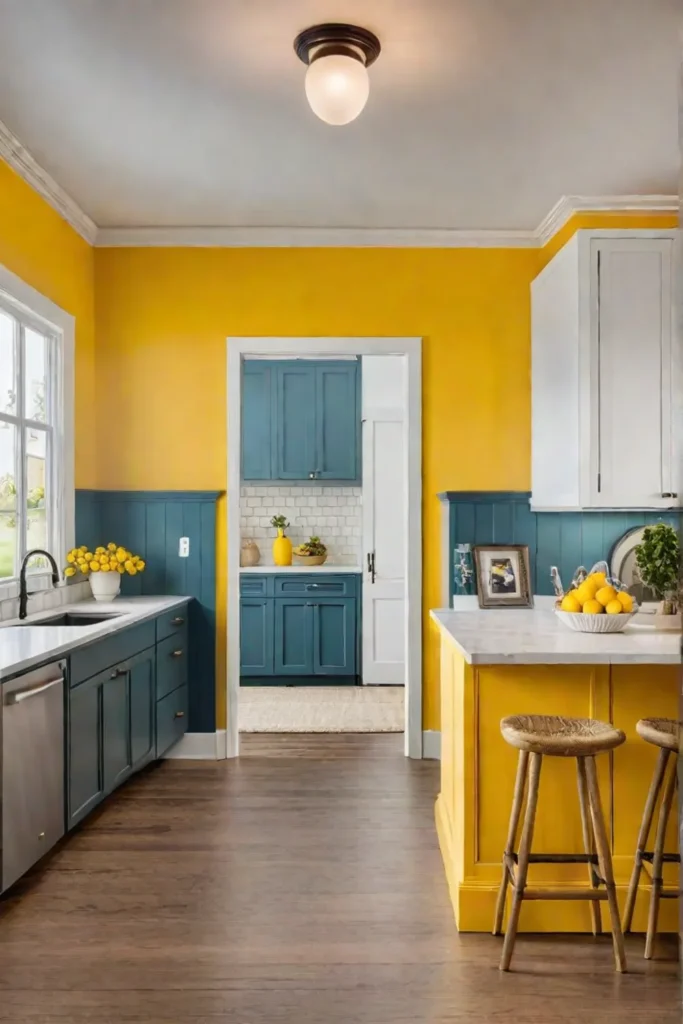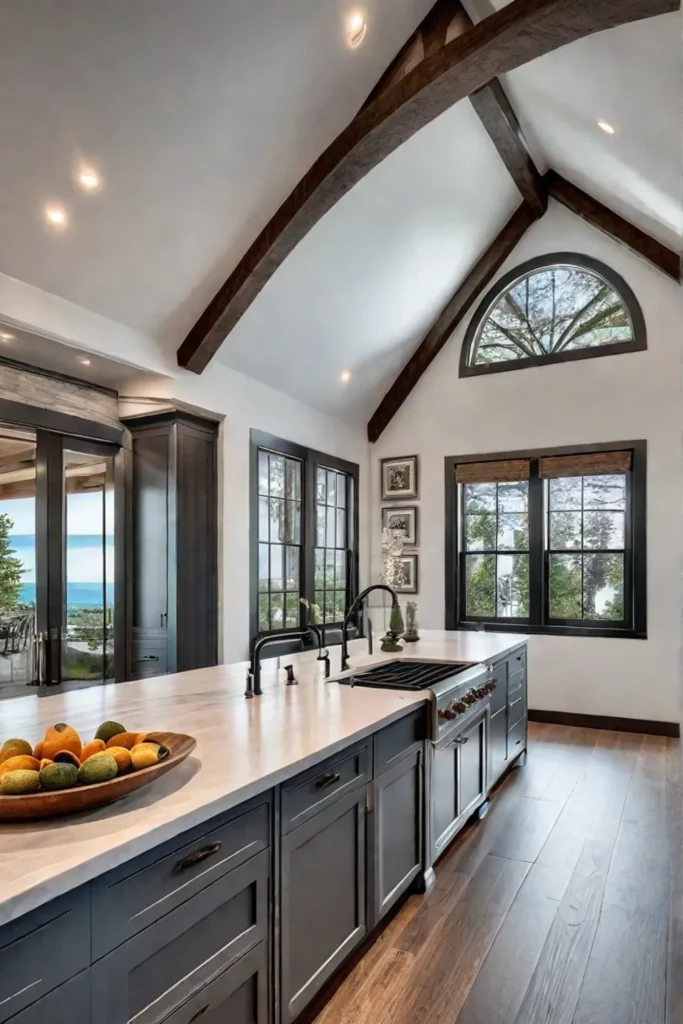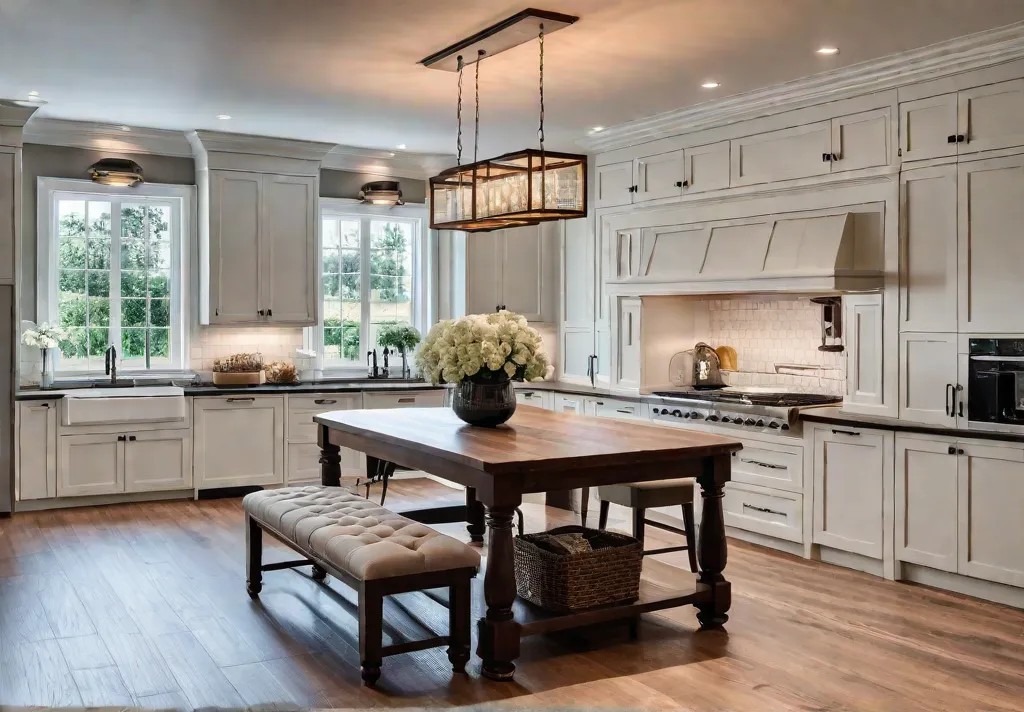Picture this: the tantalizing aroma of homemade cookies wafting through the air, the sound of laughter echoing from the kitchen as your family gathers around the island, sharing stories and creating cherished memories. This is the essence of a traditional kitchen designed with modern families in mind – a cozy, inviting space that beckons everyone to come together, connect, and savor life’s simple pleasures.
In a world where we’re constantly on the go, the kitchen serves as a sanctuary to slow down, nourish our bodies and souls, and foster meaningful connections with loved ones. It’s the heart of the home, where traditions are born and memories are made. So, how can you create a traditional kitchen that looks stunning and caters to your family’s unique needs and dynamics? Let’s explore the key elements that will transform your kitchen into a warm, welcoming gathering space.

Designing a Family-Friendly Kitchen Layout
“The kitchen is the heart of every home, for the heart of every home is the kitchen.” – Jeanne Marie Laskas
When designing a family-friendly kitchen layout, the goal is to create a space that encourages interaction, togetherness, and effortless flow. Imagine a central island or cozy breakfast nook where your family can gather for casual meals, homework sessions, or lively conversations while you whip up a delicious feast.
Fostering Togetherness with Thoughtful Design
A U-shaped or L-shaped layout can create a natural flow and conversation area, allowing family members to move seamlessly between tasks while remaining connected. A strategically placed kitchen island serves as a versatile hub for food preparation, dining, and socializing, fostering a sense of community within the heart of your home.

Studies show that families who regularly eat meals have stronger emotional bonds and better communication. Well-designed kitchen layouts can increase the time families spend in the kitchen by up to 30%, encouraging quality time together.
Maximizing Functionality and Comfort
Consider incorporating a cozy breakfast nook with built-in benches and a welcoming table for casual family meals when designing a family-friendly kitchen layout. This dedicated space adds warmth and charm and provides a comfortable gathering spot for intimate conversations or quiet moments of respite.
Optimizing traffic flow and workflow is crucial for enhancing the overall user experience. By strategically arranging the sink, stove, and refrigerator triangularly, you can streamline the movement and minimize unnecessary steps, making meal preparation and cleanup a breeze.
Selecting Durable and Family-Friendly Materials
“A kitchen must be functional above all else, but it should also be warm and inviting.” – Julia Child

Durability and low maintenance are key priorities in a traditional kitchen designed for families. After all, this space will witness countless meals, spills, and the occasional culinary mishap, and you want it to withstand the test of time with grace and resilience.
Countertops That Can Take a Beating
Quartz countertops have become popular for family kitchens due to their superior durability and low maintenance requirements. Resistant to scratches, stains, and heat, quartz offers a practical yet luxurious surface that can withstand the wear and tear of daily life.
Alternatively, granite countertops are another timeless option that can handle the demands of a busy family kitchen. With proper sealing and care, these natural stone surfaces can last for decades, adding a touch of elegance and sophistication to your traditional design.
Floors That Stand the Test of Time
When it comes to flooring, hardwood floors are a classic choice that can add warmth and character to your traditional kitchen. However, luxury vinyl plank (LVP) flooring may be a more practical option for families with young children or pets. LVP offers the look of hardwood with increased water and scratch resistance, ensuring your floors remain beautiful and intact, even in the face of accidental spills or heavy foot traffic.

Cabinetry Built to Last
Your kitchen cabinets are the workhorses of the space, storing everything from dishes and cookware to pantry staples and small appliances. Opt for solid wood or high-quality laminate cabinets that can withstand frequent use and the occasional bump or scratch. Invest in durable hardware that will stand the test of time, ensuring your cabinets remain functional and aesthetically pleasing for years.
Incorporating Comfortable and Versatile Seating
“The kitchen is the living room of the home; it’s the warm hub of the universe, where kids do homework at the counter and everyone congregates.” – Emeril Lagasse
A traditional kitchen designed for families should be more than just a functional space for cooking and cleaning – it should be a warm, inviting gathering place where everyone feels comfortable and at home. Incorporating comfortable and versatile seating options is key to achieving this welcoming atmosphere.

A Cozy Breakfast Nook for Casual Meals
Imagine starting your day with a hot cup of coffee and a delicious homemade breakfast, seated in a cozy built-in banquette with plush cushions and storage underneath. This charming breakfast nook adds character and functionality to your kitchen and provides a dedicated space for casual family meals and intimate conversations.
Perching in Comfort at the Kitchen Island
For those moments when you want to be part of the action, comfortable bar stools or counter-height chairs around the kitchen island are a must. Look for options with supportive backrests and footrests to ensure everyone can perch comfortably while enjoying a quick snack, helping with meal prep, or simply chatting with the chef.

Accommodating Larger Gatherings
Additional seating options are essential when hosting extended family gatherings or casual get-togethers. Consider placing freestanding chairs or benches near the kitchen table or island to accommodate guests and create a welcoming, inclusive atmosphere.
Studies show that families who regularly eat meals together at the kitchen table experience stronger emotional bonds and better communication. By incorporating a variety of seating options, you can increase the time your family spends in the kitchen by up to 20%, fostering cherished moments of connection and togetherness.
Embracing Timeless Decor and Accessories
“The kitchen is the heart of the home, and it should be a space that reflects your family’s unique personality and style.” – Nate Berkus

While functionality and practicality are paramount in a traditional kitchen designed for families, it’s equally important to infuse the space with warmth, character, and personal touches that make it your own. Embracing timeless decor and accessories is the key to creating an inviting space reflecting your family’s unique style.
Incorporating Classic Design Elements
Shaker-style cabinetry, farmhouse-inspired accents, and vintage-inspired artwork can add a touch of timeless charm to your traditional kitchen. These classic design elements evoke a sense of nostalgia and can increase the perceived value of your home by up to 8%.
Displaying Personal Mementos and Heirlooms
What better way to create a sense of history and belonging than by displaying family photos, heirlooms, and personal mementos throughout your kitchen? A cherished mixing bowl, a vintage clock, or a collection of framed family portraits can infuse the space with layers of warmth and meaning, contributing to a stronger sense of identity and well-being among family members.

Adding Cozy Textiles and Accents
Textiles like curtains, rugs, and throw pillows can add layers of texture and coziness to your traditional kitchen. Consider incorporating cozy plaid throws, patterned area rugs, or a vintage-inspired chalkboard to create a warm, inviting atmosphere that reflects your family’s unique style.
Designing for Functionality and Convenience
“The kitchen is the heart of the home, and it should be a space that not only looks beautiful but also functions seamlessly for your family’s daily needs.” – Bobby Berk
While aesthetics are undoubtedly important, a traditional kitchen designed for families must prioritize functionality and convenience. After all, this space is where you’ll spend countless hours preparing meals, cleaning up, and engaging in various household tasks. By incorporating thoughtful design elements, you can strike the perfect balance between form and function, creating a beautiful and highly practical space.

Optimizing Storage Solutions
Well-designed storage solutions are the key to keeping your traditional kitchen organized and clutter-free. Consider investing in custom cabinetry with pull-out shelves, dividers, and specialized storage solutions tailored to your family’s needs. These thoughtful touches can increase usable space by up to 30%, making your kitchen more spacious and inviting.
Embracing Smart Appliances and Technology
In today’s fast-paced world, every minute counts – and that’s where smart appliances and technology can be game-changers. Imagine the convenience of a Wi-Fi-enabled oven that you can control from your smartphone or a voice-activated faucet that simplifies cleanup. These modern conveniences can save families up to 2 hours per week on meal preparation and cleanup tasks, allowing you to spend more time with your loved ones.

Optimizing Kitchen Layout and Workflow
When designing a functional kitchen layout, the triangle principle is a tried-and-true approach. By strategically placing the sink, stove, and refrigerator in a triangular layout, you can optimize workflow and accessibility, ensuring a seamless and convenient cooking and cleaning experience. This thoughtful design consideration can make even the most mundane tasks feel effortless, allowing you to focus on what truly matters – creating cherished memories with your family.
Fostering a Sense of Gathering and Community
“The kitchen is the heart of every home, where memories are created and shared, and where love is always on the menu.” – Anonymous

A traditional kitchen designed for families should be more than just a functional space—it should be a warm, welcoming environment that fosters a sense of gathering and community. By incorporating design elements that promote conversation and interaction, you can create a space that encourages family members and guests to linger, connect, and create lasting memories.
Designing for Togetherness
Imagine a spacious kitchen island with ample seating, serving as the central gathering point for your family. Here, you can enjoy casual meals, work on homework assignments, or catch up on each other’s day while someone prepares a delicious feast. Alternatively, a cozy breakfast nook with built-in benches and a table can accommodate everyday meals and larger celebrations, creating a dedicated space for quality time together.
Studies show that families who eat meals together experience improved communication, stronger emotional bonds, and better overall well-being. By designing your kitchen with gathering in mind, you can foster a sense of togetherness and community within the heart of your home.

Integrating with Living Spaces
Consider incorporating an open floor plan that connects your traditional kitchen to the living room or dining area. This cohesive design creates a sense of flow and inclusivity and can increase your home’s perceived value by up to 7%. Imagine hosting a dinner party where guests can easily mingle between the kitchen and adjacent living spaces, fostering a warm, inviting atmosphere that encourages conversation and connection.
Balancing Tradition and Modern Conveniences
“A traditional kitchen should be a harmonious blend of timeless charm and modern functionality, catering to the needs of today’s families.” – Joanna Gaines

In today’s fast-paced world, it’s essential to balance timeless design elements and modern conveniences. A traditional kitchen designed for families should be aesthetically pleasing and highly functional, embracing the latest technological advancements and practical solutions.
Blending Old and New
Imagine classic shaker-style cabinetry paired with sleek, integrated appliances, creating a harmonious blend of old and new. This perfect marriage of tradition and modernity can increase a home’s perceived value by up to 12%, making it a wise investment for homeowners.
Consider selecting energy-efficient windows, lighting fixtures, and appliances that complement your traditional kitchen design. These eco-friendly choices will add a touch of modern sophistication and save families up to 20% on their annual energy costs, making your kitchen both beautiful and environmentally responsible.

Seamlessly Integrating Modern Amenities
When designing your traditional kitchen layout, seamlessly integrate modern amenities and conveniences into the overall design. For example, a central kitchen island can serve as a multi-functional hub with built-in tablet stands for easy recipe access and meal planning or even a wireless charging station for your devices.
By thoughtfully blending traditional design elements with modern conveniences, you can create a space that not only celebrates the past but also embraces the future, catering to modern families’ unique needs and lifestyles.

Crafting a Timeless Gathering Space
As you create a traditional kitchen designed for your family, remember that this space should be more than just a functional area for cooking and cleaning – a warm, inviting sanctuary that fosters togetherness, connection, and cherished memories.
By incorporating thoughtful design elements, selecting durable and family-friendly materials, and embracing timeless decor and accessories, you can create a space that not only looks stunning but also caters to the unique needs and dynamics of your loved ones.

So, whether you’re gathering around the kitchen island for a lively family meal, enjoying a quiet morning in the cozy breakfast nook, or hosting a festive celebration, your traditional kitchen will be the heart of your home – a place where traditions are born, bonds are strengthened, and love is always on the menu.
Embrace the opportunity to craft a timeless gathering space that reflects your family’s unique style and celebrates the joy of coming together. After all, the kitchen is where life happens, and it’s up to you to create a space filled with laughter, love, and cherished moments for generations to come.






